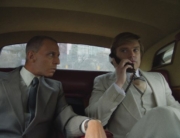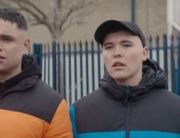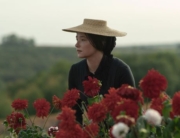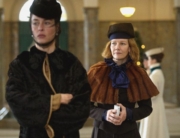A writer’s interior life is notoriously difficult to visualize on screen. It’s too often reduced to clichéd shots of typing fingers and furrowed brows as the author struggles with putting ideas down on paper. Finnish director Dome Karukoski (Tom of Finland), along with screenwriters David Gleeson and Stephen Beresford, set quite a challenge for themselves when they set out to make a biopic about one of the most imaginative novelists in English literature.
Their quest is to trace how a young John Ronald Reuel Tolkien (Harry Gilby), orphaned at an early age with his brother, Hilary (Guillermo Bedward), grew up to become the surprisingly hunky genius (Nicholas Hoult) who wrote The Hobbit and “The Lord of the Rings” trilogy and created the fantastical world known as Middle-earth. Unfortunately, their approach is dully reductive, trying too hard to literally link personal biography with a scholarly and artistic imagination of unfettered originality. There is good reason why the family and estate of JRR Tolkien recently publicly disavowed the film.
We first meet the future author in the hellish trenches of World War I France, suffering from trench fever and hallucinating battle scenes from his future books. (The loyal private serving him just happens to be named Sam, as in Frodo Baggins’s loyal companion Samwise Gamgee in the trilogy.) The film then flashes back to Tolkien’s idyllic childhood in the rustic English village of Sarehole (shades of the Shire!), where he and his brother play as medieval knights and their widowed mother, Mable (Laura Donnelly), reads them stories about dragons and treasure hoards.
Financial difficulties force the family to move to the industrial city of Birmingham, where Mabel quickly succumbs to an illness, and the boys are sent by their guardian, Father Frances (Colm Meaney), to the prestigious King Edward’s School, where young Tolkien displays his gift for languages (reciting Chaucer in Middle English) and forms a “fellowship” with three artistically minded friends. Tolkien also falls in love with a fellow orphan, Edith Bratt (Mimi Keene; Lily Collins plays the older Edith), and their romance must overcome obstacles—disapproving parental figures—that parallel Aragorn and Arwen’s love story in “LOTR.”
The elephant overshadowing this tepid, drawing-room drama is Peter Jackson’s Oscar-winning adaptation of Tolkien’s trilogy. When Tolkien, searching for one of his friends at the Battle of the Somme, ventures on the Mordor-like battlefield, the cheesy special effects conjure up the shapes of the author’s future creations: Balrog, dragons, and even Sauron. Meanwhile, Thomas Newman’s Celtic-flavored keening score is a pastiche of Howard Shore’s “LOTR” soundtrack.
Still, there are moments when the movie comes briefly alive, an indication of what might have been with a more imaginative director. In a tea room, Tolkien and Edith enjoy a flirtatious conversation about the sound of words, and when Tolkien decides to change his major at Oxford to philology after meeting Professor Joseph Wright (Derek Jacobi), this reviewer could have easily listened to a two-hour Wright lecture on language. (“Languages never steal. They influence.”)
Despite the appealing, attractive cast who do their best with a flat script, the film never really captures the man who imagined Middle-earth. To get insights into the author’s creative process, you have to go to New York City to see the Morgan Library’s current exhibit of Tolkien manuscripts, letters, photographs, and artwork. But hurry, you only have until May 12 to see this beautiful show.







Leave A Comment